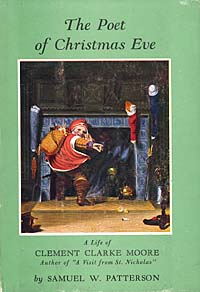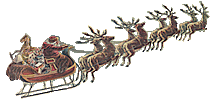 |
|
| Historical Articles | Chronological Articles |
|
Historical Arguments for Henry Livingston, Jr. as the Author of "Night Before Christmas" |
|
Popular Christmas Poem By Helen Meyers |
|
This is the time of year when we're likely to see a news story about school children honoring the memory of Clement C. Moore as the author of the Christmas verses which begin, "'Twas the night before Christmas, That perennial news story makes many people feel a little sour. They're all for honoring the memory of the man who wrote "The Night Before Christmas," but they think the wrong man is honored year after year. They believe that the author of those delightful, long-lived verses was a prominent Poughkeepsian, Henry Livingston Jr., not Clement C. Moore. The public read those verses under the title "An Account of a visit from St. Nicholas" when they were printed in the Troy Sentinel of Dec. 23, 1823. In an accompanying paragraph, the editor said that he did not know to whom the paper was indebted for them. Other publications copied the verses other Christmases, and it gradually leaked out that the author was Dr. Clement C. Moore professor of Oriental and Greek Literature at what is now General Theological Seminary in New York City, a trustee of Columbia College, and the son of the late Protestant Episcopal Bishop Benjamin Moore.
It is generally believed that Miss Harriet Butler gave a copy of the verses to the Troy paper, together with a hint of Moore's authorship. The Butler and Moore families were friendly, so friendly that Miss Butler's brother, the Rev. Clement Butler, had been named for Dr. Moore. "A Visit From St. Nicholas" appeared in an anthology published in 1837, this time as the work of Dr. Moore, and again in 1844 in his collected poems. By that time Livingston was long dead. He died Feb. 29, 1828. Meanwhile, the Livingstons of Poughkeepsie were doing a slow burn. They were convinced that "The Night Before Christmas" - they used that title rather than "A Visit From St. Nicholas" - was the work of their father and grandfather, Henry Livingston Jr.,m and that he had written it almost two decades before it was printed in Troy. When the 1884 collection of poems appeared, one Livingston connection observed sedately, "A mistake has been made."
William S. Thomas, a great grandson of Henry Livingston Jr., grew up in Poughkeepsie in what is now the professional building at 90-92 Market St. During his boyhood he heard all the pro-Livingston arguments from older members of his family. As an adult he was a practicing physician in New York City. He then gathered all the family evidence, and began presenting it to the public when the Victorian era was well over. Some of it was in an article he wrote for the 1919 "Year Book" of the Dutchess County Historical Society. More was in the 1942 "Year Book" in an article written by Helen Wilkinson Reynolds from notes of Dr. Thomas after his death.
As a result of all the publicity, the charming Christmas poem for children has become a hotly discussed adult literary problem. Some firmly believe that Dr. Moore composed it while he was riding home in a snowstorm after selecting the Christmas turkey the afternoon of Dec. 24, 1822. Even has he brushed off the clinging snow, they believe, he began to recite his new poem for the eldest of his six children, the eldest seven years old.
The pro-Livingston group still hopes that a copy of this old newspaper will turn up, perhaps in someone's attic, perhaps as the lining of an old trunk, as so many newspapers were used in that period, after they had been read.
"This autographed copy is today a priceless possession of the that [sic] Clement Clarke Moore composed the poem..." Mr. Patterson states in his book. Everyone agrees that Moore made a habit of reading the verses from a hand-written copy. Another hand-written copy is no more proof that he wrote them than a chiseled "17777" [sic] in the stone of a house is proof that the house was built that year. It's just proof that someone, sometime had a chisel and used it. That brings us to what is known of the men themselves and the other things they wrote. Livingston and Moore belonged to different generations, for the [sic] Livingston was born in 1746, Moore in 17779 [sic], but they had similar backgrounds and probably knew one another. [What is known is that Moore's father, Rev. Benjamin Moore, knew Henry's brother, Rev. Dr. John Henry Livingston. Livingston's return to his ministry in New York City at the end of the Revolutionary War occurred as Rev. Moore was being demoted because of his tilt toward the losers, so the closeness of their acquaintance is unknown. It is true that Rev. Moore subscribed to the magazine in which Henry Livingston published extensively in the early 1790's, so Clement Moore would likely have grown up reading Henry's comedic and horror prose pieces. MVD] Livingston was often in New York, and Moore was a friend and Columbia classmate of William Bard of Hyde Park. According to "Historical Notes of St. James Parish," Hyde Park, published in 1913. "Bishop Moore had officiated at William Bard's wedding, and his son, the Rev. Clement Moore, was very intimate in the family at Hyde Park, and he [Moore] read to the children his much beloved poem, "The Night Before Christmas" from the manuscript before it ever was published." [Don Foster notes that Bard described Moore's Muse as "angry," "surly," "uncourtly," and "waspish." One of the poems published in Moore's 1844 "Poems" was by Bard. MVD]
"Now for news my sweet fellow - first learn with a sigh
"When she swims in the dance or wherever she goes It continues, "Tho the fellows surround and so numble adore her The man who wrote those lively lines was born Oct. 13, 1748, at the home of his father, a grandson of Robert Livingston, the first lord of Livingston Manor. Henry Livingston, the father, then owned a large river-front property about a mile south of the little village of Poughkeepsie.
Did the author of "The Night Before Christmas" hang his stocking from the mantel as a child? Even if we accept Henry Livingston Jr. as the author of the poem, there's some doubt about the mantel. Fireplaces of the mid-18th century had simple frames only. But the columns and other decorations may have been added to such an original simple frame late in the century.
When Henry Livingston Jr. married shortly before the Revolution his father gave him part of his own big property, a 250-acre farm west of the Albany Post Road. This property is now basically the estate of Miss Annette Young, South Road. Henry Livingston Jr. was a surveyor who drew many precise maps of property in this area, often ornamented with borders and charming pictures. He actively operated his farm. He had a landing for sloops with a storehouse on the Hudson, and he had a saw mill. With all that he found time to write and draw for magazine publication, to write verses for local newspapers, to write more verses for his friends and his family, and to play the violin and the flute. He loved gayety, and one of his favorite exclamations was "Dunder and Blitzen." He was quite a man, Henry Livingston Jr.
"Before the friends of Mr. Power
One is written "To my little niece, Sally Livingston on the death of a little serenading wren she admired." Another is for another niece Ann Duyckinck, on her ninth birthday, and a third is for Timmy Dwight on his seventh birthday. Clement C. Moore's writing was something else again. His first publication was a Hebrew Lexicon, on which he spent several years. Of this Mr. Patterson says, it "was never an outstanding success, but it had the distinction of being the first published in America." Then there was the translation of "A Complete Treatise on Merino and Other Sheep" from the French. Patterson says of this. "It is a compilation by a French author, Alexandre Henri Tessier. The work poses a problem and raises a question. The problem concerns the appendix where Francis Durand is named as 'Proprietor and Translator,' though Moore wrote his name as the translator on the copy he presented to the New-York Historical society." Moore also wrote two pamphlets in which he attacked Thomas Jefferson and the "snips of knowledge" he exhibited in his recently republished "Notes on Virginia." He considered irreligious such things as Jefferson's observation on petrified shells 15,000 feet above sea level. In an introduction to a contemporary's translation of Juvenal, Moore said that "No production which assumes the guise of poetry ought to be tolerated, if it possesses no other recommendation than the glow of its expressions and the tinkling of its syllables..." That's a nice phrase, "tinkling of its syllabels." And how well it expresses the allure of "The Night Before Christmas." It wouold be interesting to know how Moore correlated his condemnation of light verse with authorship of such lines as, "He had a broad face
"Think me no matron stern who would repress This is Livingston on the same subject: "For us (and I blush when I speak I declare) and more in the same light vein.
He also wrote a group of 12 stanzas addressed "To My CChildren After Having My PORTRAIT Taken for Them." The first two are, "This semblance of your parent's time-worn face Since this was printed in the 1837 collection, along with "A Visit From St. Nicholas," he couldn't have been more than 58 when he wrote it. He lived until five days before his 84th birthday in 1863. This is the way Livingston began one of his verses for children, the one for Ann Duyckinck's ninth birthday, "To his charming black-eyed niece Moore also had a go at biography, a book titled "George Castriot, Surnamed Scanderbeg, King of Albania." Of this Patterson says, "He does not appear originally to have considered the book his own, but simply a popular revision of Lavardin's capital work." Moore's biographer concludes on the basis of this work that "Perhaps a poet should not write history." Then there's that collection of Moore's poems; published in 1844. In her book int he 1942 Year Book, Miss Reynolds noted, "The volume contains 37 poems and, in the preface, over his own signature, Dr. Moore states that every thing in the book was written by himself, except two items which, he said, were written by his wife. "Examination of the book reveals, however, that of the 37 poems 7 were not written by Dr. Moore. Two were by Mrs. Moore, as he said. Sub-titles show that one was written by William Bard and one by 'P. Hone.' Two were translations from Italian authors and one was a translation from the Greek. "Of the rest, 21 have sub-titles stating when and why Dr. Moore wrote them; 8 have no sub-titles; and finally, a ninth without a sub-title is headed: 'A Visit from St. Nicholas.'" Miss Reynolds concluded that Dr. Moore's book was "carelessly compiled." And here we have William Bard again, emphasizing Moore's ties with Dutchess County and the social group which included the Bards and the Livingstons. Who do YOU think wrote the verses which begin "'Twas the night before Christmas..."?
|


![]() Copyright © 2014, InterMedia Enterprises
Copyright © 2014, InterMedia Enterprises